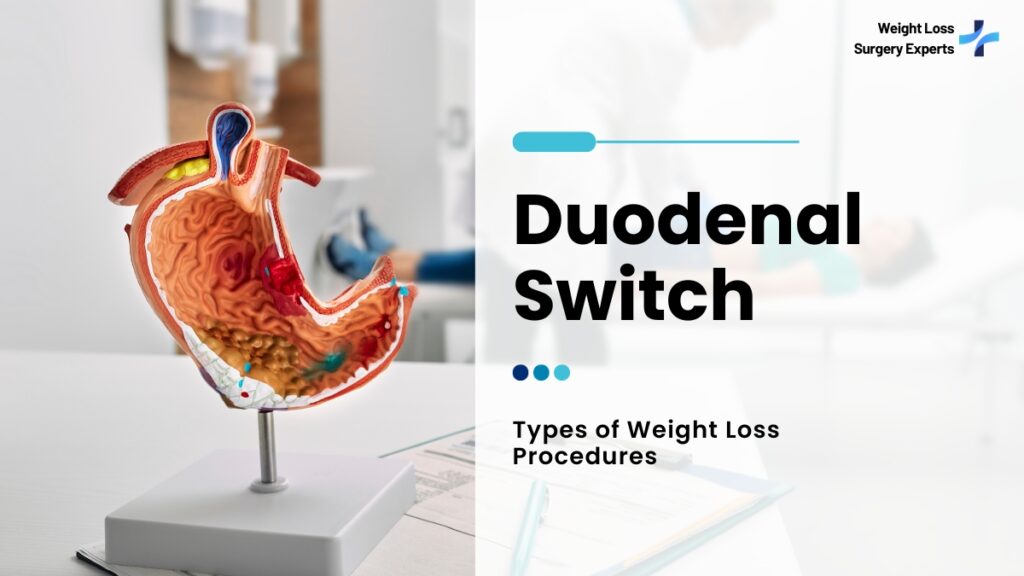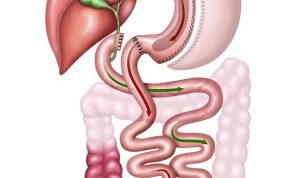The duodenal switch (also known as biliopancreatic diversion with duodenal switch) is a weight loss surgery procedure that uses both a malabsorptive and restrictive approach. The restrictive part of surgery removes nearly 70% of the stomach.
The malabsorptive portion of the surgery works on rerouting a large part of the small intestine leading to two different separate pathways and one common channel. The objective of this surgery is to reduce the time it takes for the body to capture calories in the small intestine and to lower the absorption of fat overall.
Patients will only absorb about 20% of the fat intake. After surgery, patients will feel full quicker than when their stomach is a normal size.
Candidates for Duodenal Switch Surgery
Typically duodenal switch surgery is for individuals who are super obese with a body mass index (BMI) of 50 or higher or whose weight is causing them serious health problems. Some surgeons may opt for patients with a BMI of over 40 or individuals with a BMI of 35 or more with at least one comorbidity such as heart disease, Type II Diabetes, sleep apnea, or high blood pressure. It’s always important to consider surgery as a tool to help you lose weight. It is never a quick fix for obesity. A regular exercise routine and a healthy diet will help patients reach their weight loss goals.
Different Types of Duodenal Switch
Biliopancreatic diversion removes a portion of the stomach. The remaining part of the stomach is then connected to the lower portion of the small intestine organ. This is considered a high-risk surgery that can cause long-term health issues because the body now will have a harder time absorbing nutrients.
Biliopancreatic diversion with a duodenal switch involves a different part of the stomach that is removed. However, the pylorus valve is left intact. This valve controls food drainage in the stomach.
Both of these bariatric procedures can be done in an open procedure with a large cut across the abdomen or by making a series of small cuts laparoscopically.
Risks of Duodenal Switch Surgery
Some common risks associated with all weight loss surgeries include stomach leakages, infection, deep vein thrombosis, pulmonary embolism, infection at the incision, gallstones, anemia, and osteoporosis. Some risks directly associated with duodenal switch surgery are dumping syndrome, a condition that can cause faintness, sweating, nausea, vomiting, and diarrhea.
Patients also have a higher risk of osteoporosis since their bodies can no longer absorb nutrients at the same rate. Diarrhea occurs because of the poor absorption of protein, fat, iron, and vitamins B12, A, D, E, and K.
What to Expect After Duodenal Switch Surgery?
Some belly pain will occur and pain medication will be needed for at least the first week following surgery. The incision site may also be sore and tender. Because this weight loss surgery makes the stomach smaller, you will feel full a lot quicker.
A strict diet must be followed after DS surgery. For the first month following surgery, your stomach can only handle soft foods or liquids while the healing process occurs. Also, stay hydrated and sip water throughout the day. Bowel movements may not be regular immediately following surgery, don’t worry this is normal.
When solid foods are added back to your diet, chew food thoroughly and stop eating immediately when you feel full. If you continue to overeat, your stomach will stretch thus eliminating the benefits of this bariatric surgical procedure.
Because this surgery removes a part of the small intestines where many vitamins and minerals are absorbed, patients must take regular vitamin supplements for optimal health. A dietitian can help devise a plan for meals and supplements for each patient. Vitamin B12 will be especially low in DS patients.
Depending on how the surgery was performed, you will have to avoid any heavy lifting or strenuous exercise. Generally, those who have open surgery will need 4-6 weeks to recover while those who had the surgery laparoscopically will just need 1-2 weeks tops.
Success Rates
According to recent studies, many DS patients can expect to lose 75-80% of their excess weight. Nearly 10 years after weight loss surgery, some individuals have gained back 20-25% of the weight they lost. This makes the long-term commitment that much more important for those embarking on weight loss surgery.
Advantages of Duodenal Switch Surgery
The primary advantage of this type of weight loss surgery is the combination of moderate caloric intake with calorie malabsorption results in a high percentage of weight loss. Because the pyloric valve remains intact, people do not generally experience the dumping syndrome common with those who have gastric bypass (Roux-en-Y) surgery.
Also, much of the production of ghrelin, the hunger hormone, is removed when the portion of the stomach is taken out. Also, the diet following duodenal switch surgery is better tolerated than other bariatric surgeries. Also, the malabsorptive part of the surgery is fully reversible because the small intestine is only rerouted and not removed.
Statistically, this surgery has the greatest weight loss success than any other weight loss procedure. It also has the highest resolution of high blood pressure, high cholesterol, and diabetes. It is an effective choice for those with a diet high in fat.
It also can be used in conjunction with another weight loss procedure such as a lap band or gastric bypass for those needing to lose enough weight to qualify safely for other procedures.
Disadvantages of Duodenal Switch Surgery
The biggest disadvantage of Duodenal Switch surgery is the amount of time that the operation takes. The longer a patient needs to be under anesthesia, the higher their risk for complications post-op. Typically duodenal switch surgery takes anywhere from three to six hours.
Also, there are fewer qualified DS surgeons because of the intensity. Also, the partial gastrectomy part of DS surgery is not reversible (unlike the small intestine malabsorptive part). Once the stomach is removed it is gone and can never be rebuilt or reattached.
In terms of the malabsorptive part, there is a high chance of protein deficiency (anemia) and metabolic bone disease if the proper diet is not maintained. Patients will need regular blood work and labs to ensure that any deficiencies are detected quickly. Duodenal Switch surgery can lead to gas or flatulence issues in patients as well as a loose stool.
Cost of Duodenal Switch Surgery
Duodenal switch surgery is one of the most expensive in terms of weight loss surgery options. This is because it combines two procedures together. The price range for the surgery itself falls between $22,000-$42,000 though costs vary by each state. Generally, the use of the surgical facility, surgeon’s fees, anesthesiologist’s fees, pain medication and antibiotics, hospital stay, and all follow-up visits are included in the cost.
Some insurance companies may cover the operation or at least a portion of the cost. Insurance will require a surgeon to prove your need for the surgical procedure with documentation of your medical history and failing health. They most likely will want you to complete a 6-month diet with a medical professional too to ensure that you can follow a healthy lifestyle and will do so following surgery for optimal success.
If you have Medicare, the insurance company typically pays 100%. Medicare has its unique requirements, so you will need to make sure that you meet their criteria. Medicaid does not cover Duodenal Switch surgery although it does cover many other weight loss surgery procedures.
Ultimately while it is important to weigh the costs associated with duodenal switch surgery, never sacrifice quality for a cheap price.


